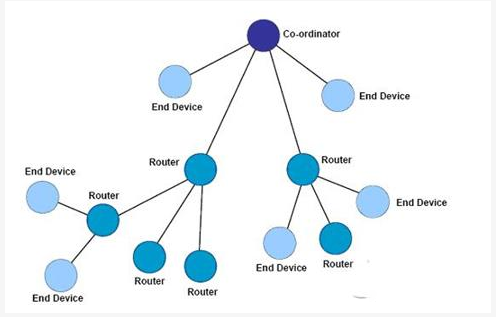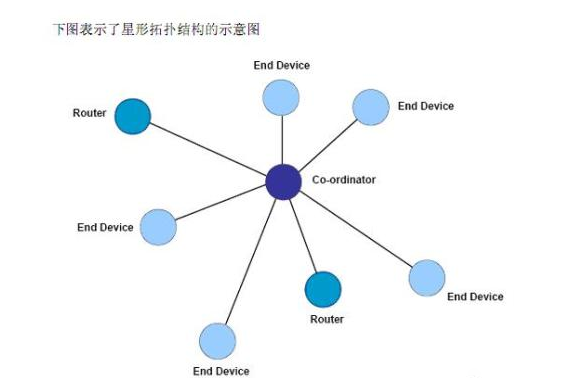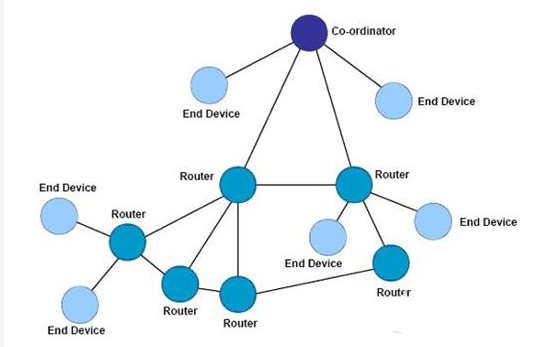Wireless sensor network (WSN) is a collection of small sensor nodes with sensing, computing and transmission capabilities. Since the functions of a single sensor node are limited, especially energy storage and data storage, a good network topology and routing protocol need to be developed. This paper focuses on the Zig Bee wireless sensor network based on the IEEE 802.15.4 standard, and proposes an efficient clustering topology MSCT based on the minimum spanning tree (MST). The ultimate goal is to build a network topology with the minimum cost. The topology in this paper also takes indoor environments into account, proposing metrics to handle path loss and signal attenuation caused by walls and obstacles, and calculating the weights of links between nodes. Finally, the MSCT topology proposed in the paper is more advantageous than the Cluster-Tree topology through energy loss and network life.
Each of the three Zigbee network structures has its own advantages. The Zigbee network currently has three architectures: star, tree and mesh. You can choose the appropriate Zigbee network structure according to actual project needs.
1. Star topology
It is the simplest form of topology. It contains a Co-ordinator node and a series of End Device nodes. Each End Device node can only communicate with the Co-ordinator node. If communication is required between two End Device nodes, information must be forwarded through the Co-ordinator node.

2. Tree topology
The tree topology includes a Co-ordinator and a series of Router and End Device nodes. Co-ordinator connects a series of Routers and End Devices, and its sub-node Routers can also connect a series of Routers and End Devices. This can be repeated for multiple levels. The structure of the tree topology is shown in the figure below:

have to be aware of is:
Co-ordinator and Router nodes can contain their own child nodes.
End Device cannot have its own child nodes.
Nodes with the same parent node are called sibling nodes
Nodes with the same grandparent node are called cousin nodes.
Communication rules in tree topology:
Each node can only communicate with its parent node and child nodes.
If data needs to be sent from one node to another, the information is passed up the path of the tree to the nearest ancestor node and then down to the destination node.
The disadvantage of this topology is that there is only one routing channel for information. In addition, the routing of information is handled by the protocol stack layer, and the entire routing process is completely transparent to the application layer.
The construction of the network is different from the Cluster-Tree structure described previously. It is based on minimum spanning tree. Assume that the graph G = (V, E) represents the topology of a static sensor network, where V represents a sensor node and E represents the link weight between two connected nodes. Theoretically, the link weight of a sensor network represents the Euclidean distance between two nodes, but as explained in the previous section, path loss and signal attenuation due to obstacles in the indoor environment must be taken into account. The weights are sorted using the “Kruskal” based algorithm [6-7] (Algorithm 1, shown below). According to this algorithm, the topology with the minimum communication transmission cost can be obtained.
3. Mesh topology
Mesh topology includes a Co-ordinator and a series of Routers and End Devices. This form of network topology is the same as a tree topology; please refer to the tree network topology mentioned above. However, mesh network topology has more flexible information routing rules, and routing nodes can communicate directly with each other when possible. This routing mechanism makes the communication of information more efficient, and means that once a problem occurs on one routing path, the information can be automatically transmitted along other routing paths. A schematic diagram of a mesh topology is shown below:

Usually in the implementation of supporting mesh network, the network layer will provide corresponding route exploration function. This feature allows the network layer to find the optimal path for information transmission. It should be noted that the above-mentioned features are all implemented by the network layer, and the application layer does not need any participation.
The MESH mesh network topology has powerful functions. The network can communicate through “multi-level hops”; this topology can also form an extremely complex network; the network also has self-organizing and self-healing functions;
With the rapid development of wireless sensor networks, wireless technology is widely used in base stations that transmit surveying and mapping data [1]. Wireless sensor networks require large-area deployment in practical applications. Once the deployment is completed, it is relatively difficult to change the deployment again. This is why it is necessary to efficiently use the limited resources of each node in the network. There are many application fields of wireless sensors, such as temperature and humidity monitoring, home automation, rescue monitoring, etc. Most applications require large-scale wireless transmission and need to be supported by standards such as IEEE802.11b. Relevant studies have shown that traditional wireless standards such as Bluetooth and WLAN [2] are no longer suitable for applications in home automation and industrial indoor detection scenarios. The IEEE802.15.4 standard is usually chosen for this application scenario. This paper focuses on the study of the efficient clustering topology MSCT based on the minimum spanning tree (MST) under the condition of indoor wall interference. 1Cluster-Tree network topology Cluster-Tree is a network topology based on the IEEE802.15.4 standard. In wireless sensor networks, energy consumption is an important part that must be considered. This article will first study the efficiency of Cluster-Tree network topology in terms of energy consumption [3]. The Cluster-Tree network topology is divided into two hierarchical relationships, parent and child, as shown in Figure 1. In this topology, each cluster node communicates through the head node of this level, and the head node of each layer is controlled by the PAN coordinator [4]. The topology is constructed through association requests and association responses. In order to achieve the best control effect of the ZigBee network type, the number and extension depth of each parent node’s child nodes must be within a certain range. The depth here refers to the distance between the PAN coordinator and the node. For example: the node of the PAN coordinator is regarded as level 0, and the child node of the PAN coordinator is regarded as level 1
Keywords: data transmission terminal
